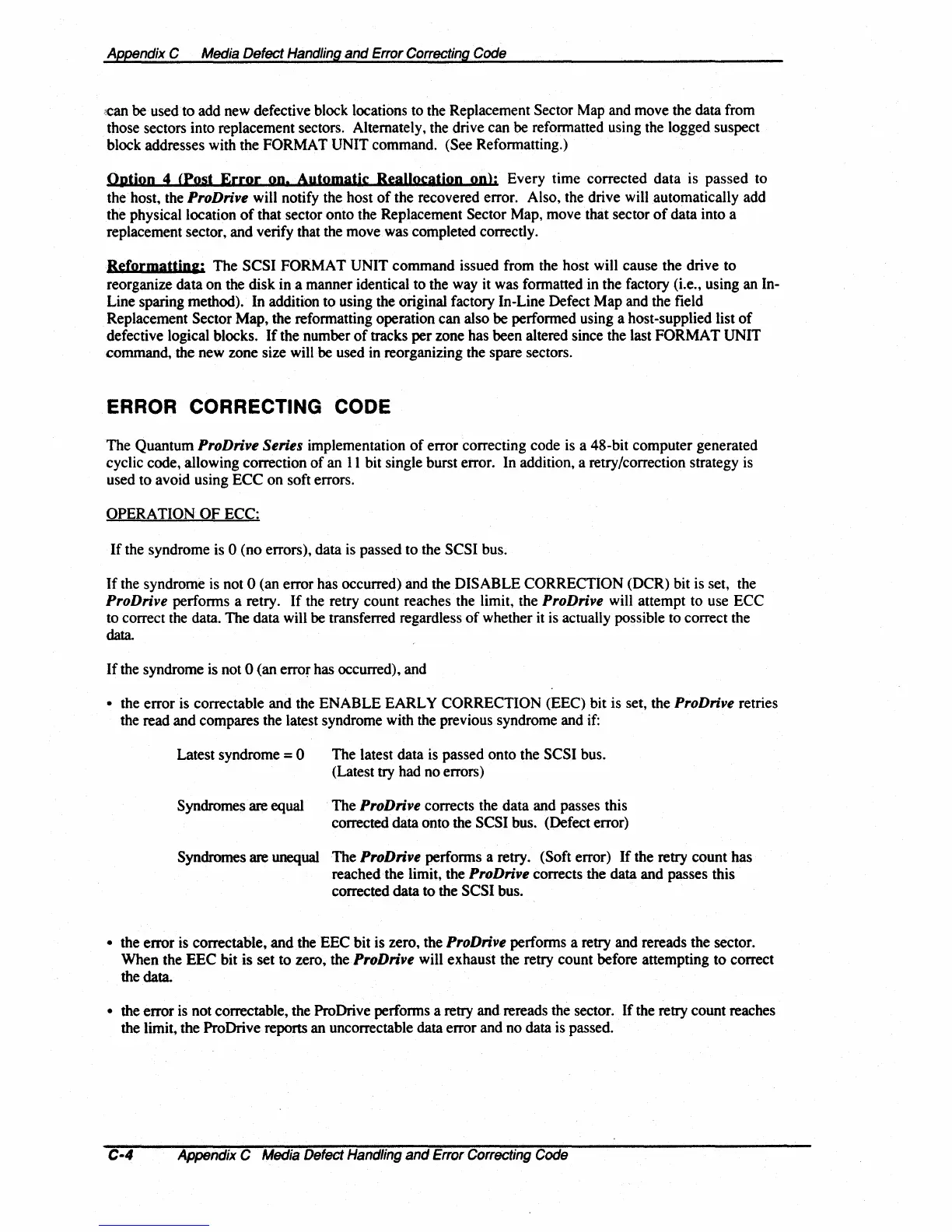Appendix C
Media
Defect
Handling
and Error
Correcting
Code
'!can
be used
to
add new defective block locations to the Replacement Sector Map and move the data from
those sectors into replacement sectors. Alternately, the drive can
be reformatted using the logged suspect
block addresses with the
FORMAT UNIT command. (See Reformatting.)
Option
4
(Post
Error
00.
Automatic
Reallocatjon
on)i
Every time corrected data is passed to
the host, the ProDrive will notify the host
of
the recovered error. Also, the drive will automatically add
the physical location
of
that sector onto the Replacement Sector Map, move that sector
of
data into a
replacement sector, and verify that the move was completed correctly.
ReformattjOli
The SCSI FORMAT UNIT command issued from the host will cause the drive to
reorganize data on the disk in a manner identical to the way it was formatted in the factory (Le., using an In-
Line sparing method). In addition to using the original factory In-Line Defect Map and the field
Replacement Sector Map, the reformatting operation can also be performed using a host-supplied list
of
defective logical blocks.
If
the number
of
tracks per zone has been altered since the last FORMAT UNIT
command, the new zone size will be used in reorganizing the spare sectors.
ERROR CORRECTING CODE
The Quantum ProDrive Series implementation
of
error correcting code is a 48-bit computer generated
cyclic code, allowing correction
of
an
11
bit single burst error. In addition, a retry/correction strategy is
used to avoid using ECC on soft errors.
OPERATION
OF
ECC:
If
the syndrome is 0 (no errors), data is passed to the SCSI bus.
If
the syndrome is not 0 (an error has occurred) and the DISABLE CORRECTION (OCR) bit is set, the
ProDrive performs a retry.
If
the retry count reaches the limit, the ProDrive will attempt to use ECC
to correct the data. The data will be transferred regardless
of
whether it is actually possible to correct the
data.
If
the syndrome is not 0 (an error has occurred), and
• the error is correctable and the ENABLE EARL Y CORRECTION (EEC) bit is set, the ProDrive retries
the read and compares the latest syndrome with the previous syndrome and if:
Latest syndrome
= 0
Syndromes are
equal
The latest data is passed onto the SCSI bus.
(Latest try had no errors)
The
ProDrive corrects the data and passes this
corrected data onto the SCSI bus. (Defect error)
Syndromes are
unequal
The ProDrive performs a retry. (Soft error)
If
the retry count has
reached the limit, the
ProDrive corrects the data and passes this
corrected data to the
SCSI bus.
• the error is correctable, and the EEC bit is zero, the ProDrive performs a retry and rereads the sector.
When the EEC bit is set to zero, the ProDrive will exhaust the retry count before attempting to correct
the data.
• the error is not correctable, the ProDrive performs a retry and rereads the sector.
If
the retry count reaches
the limit, the ProDrive reports an uncorrectable data error and no data is passed.
C-4 Appendix C
Media
Defect
Handling
and Error Correcting
Code

